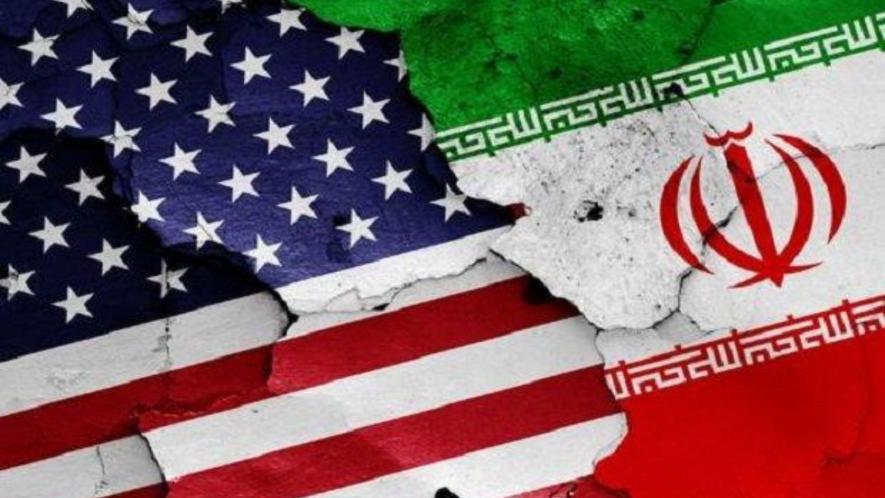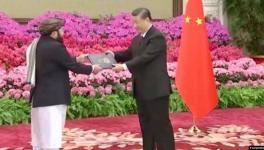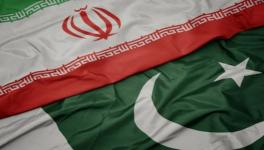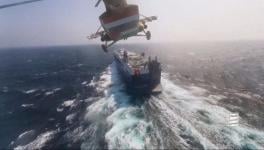US Embarks on Proxy war Against Iran

A massive US naval deployment in a wide arc of the so-called Greater West Asia is under way — stretching from Crete in the Eastern Mediterranean, into the Red Sea and the Bab el Mandeb and into the Gulf of Aden and all the way into the Gulf of Oman. This deterrent display may transform as large-scale offensive operations and aims to rework the geopolitical alignments and bring them back to the traditional grooves of intra-regional rivalries in the Gulf region.
Ship spotters first said that as of Thursday, the aircraft carrier USS Dwight D. Eisenhower and its escorts were sailing just outside the Strait of Hormuz in the Gulf of Oman, and were approaching the Persian Gulf. A Pentagon official confirmed the location but would not say whether the carrier will enter the Persian Gulf passing through the Strait of Hormuz.
The US naval build-up in the region consists of another carrier strike group as well — USS Ford and its escorts — which last week moved away from Israeli coast and is now re-positioned to the south of Crete, according to ship spotters, apparently beyond the missile reach of Lebanon’s Hezbollah.
Apart from the two carrier strike groups, the US deployment also includes a three-ship Bataan Amphibious Ready Group with the 26th Marine Expeditionary Unit and several guided-missile destroyers — USS Bataan and USS Carter Hall operating in the northern portion of the Red Sea, and USS Mesa Verde in the Eastern Mediterranean along with the command ship USS Mount Whitney.
Additionally, there are some number of US attack submarines in the region, but the Pentagon does not typically disclose their locations — except for a rare disclosure recently by the US Central Command of the transit on November 5 of nuclear guided-missile submarine USS Florida to the east of Suez.
The most obvious explanation for such a formidable naval buildup is that it is part of the US effort to keep the current conflict in southern Israel and Gaza contained.
Hezbollah continues to fire rockets and anti-tank missiles into Israel from Lebanon; Iran-backed Shia militant groups are attacking US bases in Iraq and Syria; and Houthi rebels in Yemen are firing missiles towards Israel. During the period since October 17, there have been at least 58 attacks on US bases, mostly in Iraq.
The hardline opinion in the US is that the militant groups attacking the US forces are acting at Iran’s behest. This allegation is an old US-Israeli bogey and keeps surging whenever Iran is in the crosshairs and/or there is requirement of a blame game. Expert opinion, including in the US, has always been wary of it.
Longtime observers estimate that while Tehran is openly helping the various resistance groups operating in West Asia to push back the US and Israel, that does not exactly make these groups “Iranian proxies”. Thus, it transpired that Iran was taken by surprise by the Hamas attack against Israel on October 7. According to Reuters, at a recent meeting in Tehran with Ismail Haniyeh, the chairman of the group’s political bureau, Iran’s supreme leader Ayatollah Ali Khamenei brought this up.
At any rate, it is a known fact that the US establishment is well aware of the ground realities of its state of play with Iran and has not hesitated to use back channels to lean on Tehran to use its good offices with the Shia militant groups operating in Iraq to exercise restraint. But the bottom line is that Iran too has its limitations in such extraordinary times such as today when hatred and anger towards the US and Israel has risen to a crescendo in the Muslim countries.
Interestingly, coinciding with the arrival of the aircraft carrier USS Dwight D. Eisenhower and its escorts in the waters off the Strait of Hormuz, the International Maritime Security Construct [IMSC] — a consortium of countries headquartered in Bahrain, whose official stated aim is the maintenance of order and security in the Persian Gulf, Gulf of Oman, Gulf of Aden and Southern Red Sea, particularly regarding maritime security of global oil supply routes — issued an advisory on Thursday for vessels travelling through the approaches to Bab al Mandeb and Red Sea and specifically advising that “when choosing routes, orient toward creating maximum feasible distance from Yemeni waters.”
Two days later, the Israeli military has said that Yemen’s Houthis had actually seized a cargo ship in the southern Red Sea as it was sailing from Turkiye to India; although the military added that the vessel was not Israeli-owned and had no Israelis among its crew, ownership details in public shipping databases associated the ship’s owners with Ray Car Carriers, which was founded by Abraham “Rami” Ungar, who is known as one of the richest men in Israel.
It doesn’t need much ingenuity to figure out that the US, which is already smarting under the humiliation of the Houthis shooting down a US MQ-9 Reaper drone over international waters recently, is moving against the Houthis. This needs some explaining.
The point is, IMSC is a US-led “coalition of the willing” outside the purview of the mission of the International Maritime Organisation, the United Nations specialised agency “to promote safe, secure, environmentally sound, efficient and sustainable shipping through cooperation.”
It was established in 2019 against the backdrop of the war in Yemen and comprises, amongst others, the UAE and Saudi Arabia from the Gulf region. Its leitmotif was to counter the Iran-Houthi axis during the Saudi-Emirati intervention in Yemen — essentially, as part of the US’ containment strategy against Iran dominating the regional politics at that time.
Significantly, if the Biden Administration plans to hit the Houthis and makes it look as a retaliatory / punitive strike and to that end, it is invoking the IMSC platform, which belongs to a bygone era before the Saudi-Iran rapprochement brokered by China, that becomes a brilliant geopolitical ploy where the US hopes to achieve multiple objectives kill many birds with a single arrow.
These objectives range from bringing down Iran by a notch or two in the regional folklore of power dynamic; driving a wedge between Saudi Arabia and Iran at a juncture when the amity between the two traditional rivals is frustrating the US plans to “integrate” Israel; re-establishing the shock and awe of US power in West Asia and globally; keeping the Red Sea shipping lines open for Israeli vessels; and, in strategic terms, dominating the waterways of the Red Sea leading to the Suez Canal.
By the way, Red Sea is lately witnessing big power contestation — China has a naval base in Djibouti and Russia hopes to establish a submarine base in Sudan; Eritrea is a virulently anti-US littoral state on Red Sea; and, US is desperately trying for a regime change in Ethiopia, the largest country in the African continent, which is on very friendly terms with Russia.
Even more curious is the timing of the US aircraft carrier group in the Persian Gulf region. The Chinese foreign ministry announced on Sunday that a delegation consisting of Arab and Islamic foreign ministers will visit China from November 20 to 21 to hold “in-depth communication and coordination” with Beijing “on ways to deescalate the ongoing Palestinian-Israeli conflict, protect civilians and seek a just settlement of the Palestinian question.”
The delegation comprises Saudi Foreign Minister Prince Faisal bin Farhan Al Saud, Jordanian Deputy Prime Minister and Foreign Minister Ayman Safadi, Egyptian Foreign Minister Sameh Shoukry, Indonesian Foreign Minister Retno Marsudi, Palestinian Foreign Minister Riyad Al-Maliki and Secretary General of the Organisation of Islamic Cooperation Hussein Brahim Taha.
The above development is a Saudi initiative. There is no question that the collective outreach by the Muslim countries to China as their principal interlocutor at the present stage of the Palestine-Israel conflict is a diplomatic rebuff to the US. Succinctly put, the Arab unity is also becoming a thorn in the flesh for President Biden at a time when the US finds it increasingly difficult to block the Chinese-Arab push for a ceasefire in Gaza and counter the international condemnation of Israel’s horrific violence against the Palestinian people, especially in the Global South.
By attacking the Houthis of Yemen, the Biden administration’s game plan is to undermine the Saudi-Iran rapprochement by playing on the Saudi antipathy toward the Houthis on the one hand and taunting Tehran on the other hand. Basically, the US hopes to pay Iran back in the same coin.
As an opinion piece in the Hill put it, “It is time Biden and his principal advisers on his national security team… must assume an active defence by striking Iranian proxies hard and unapologetically, when they present a threat, not after they have already attacked. And probable cause must be good enough for protecting our service members manning remote bases in Iraq and Syria… bloody nose is the only response Iran understands, and precisely the response the US must deliver.” (here)
The Biden Administration must be sensing already that the Israeli operations against Hamas are not getting anywhere and may turn into a long day’s journey into night, thanks to the Zionist state’s stubborn refusal to confront its guilt and shame or accept a two-state solution to the Palestine issue. The American public opinion is becoming sceptical about Biden’s handling for the situation and the US’ allies feel troubled. Indeed, Israel itself is a deeply divided house.
Meanwhile, the US’ diplomatic isolation in West Asia is touching an unprecedented level today. The big question is whether through coercion — “smart power” — it is possible to retrieve lost ground where the crux of the matter is that the US is not trusted anymore in West Asia. Moreover, Iran holds the patent for “smart power,” which it has finessed as a diplomatic tool through the past four decades successfully to ward off existential challenges from the US.
The US risks getting entangled with the resistance groups, which have nothing to lose and everything to gain by creating a quagmire for Washington. The heart of the matter is that the resistance groups are operating in their native lands and enjoy vast networks of social support. This, therefore, becomes an unequal battle, in the final analysis.
Whether it is worth taking the risk — all for the sake of boosting the sagging Israeli morale — should be a soul-searching question for the Biden Administration before embarking on yet another forever war in West Asia.
MK Bhadrakumar is a former diplomat. He was India’s ambassador to Uzbekistan and Turkey. The views are personal.
Courtesy: Indian Punchline
Get the latest reports & analysis with people's perspective on Protests, movements & deep analytical videos, discussions of the current affairs in your Telegram app. Subscribe to NewsClick's Telegram channel & get Real-Time updates on stories, as they get published on our website.
























